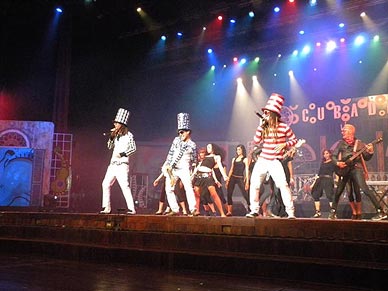13.35.1 Free Qva.

Qva Libre, a Cuban alternative music group founded in 2000 under the tutelage of three musicians and friends: Carlos (guitar), Giordano (bass), and Frank (lead vocals). Their debut performance was during the Closing Summer Rock Festival on August 25, 2001, at Havana’s underground rock scene, “El Patio de María.”
Other members include José Carlos (El Plevy), who joined the band in 2001, providing lead vocals and minor percussion. Alsídes (El Nene) and Tito joined months later, the former as a drummer and the latter also on percussion.
That same year, they performed several times on the stage where they performed for the first time in front of an audience. In 2002, having already won over a young audience, they participated in several festivals and gave performances throughout the Cuban archipelago. These included the Youth Music Festival, the anniversary of the television program Cuerda Viva, the Summer Festival, and the May Pilgrimages.
Two years later, Qva Libre entered a recording studio for the first time to record a demo, conceived with their own resources and titled “Que todo sea para nada” (That’s All for Nothing). Nada, Guajira, Bacalao con Pan (DR), and María are the four tracks featured on the demo. In the middle of that year, two new musicians joined the band, replacing the drummer and percussionist: David Smith (drums) and Pitaluga (El Pita, percussion and backing vocals).
It is during this period that the group achieves greater maturity and stability in terms of its music.
In 2005, they performed successfully alongside other Cuban musicians. They appeared in the Spanish film Habana Blues by director Benito Zambrano, which was filmed in Havana. This film addresses the topic of the alternative music movement in Cuba.
In July of that year, they recorded their debut album, Resistencia y reciclación, an independently produced album. This album was widely received by both the public and the media. Among the guest musicians were the Camerata Romeu; it features twelve tracks and the musical production was by Juan Antonio Leiva. To promote the album, they performed concerts in various regions of the country. They also appeared on the television program Paréntesis.
In 2006, they staged a major performance concert, “Resistance and Recycling,” at the Hispanic American Cultural Center. The concert featured musical production by Juan Antonio Leiva and also featured performances by the Makinah visual arts group and the Giganteria street theater group. Another notable performance was the concert to mark the release of their music video, “Meterte Adentro.”
At the universities of Cienfuegos and the Central University of Las Villas, around this time, they gave two concerts celebrating the seventh FEU and student congress. They made a short trip to the cities of Cienfuegos and Santa Clara. They participated in the first rock fusion festival, Rock en el Río, in San Antonio de los Baños.
In the music that Qva Libre cultivates, they blend genres such as rock, funk, and hip hop with the rhythms and elements of Cuban music. This gives their songs a new meaning and originality.
Their songs have been featured on major Cuban television programs. Together with renowned music producer Juan Antonio Leiva, they have created countless musical works, including the music for the Cuban soap opera Hola Habana, as well as several concerts.
Qva Libre has shared the stage with prominent figures in Cuban music, such as Telmarys Díaz, Kumar, William Vivanco, Roberto Carcassés, and many others. They have also interacted with foreign groups and artists such as No te va a gustar, Junkard Empire, and Basque musician Fermin Muguruza.
He has also performed his music in various venues such as the Casa de las Américas (3rd and G Streets, Vedado, Plaza de la Revolución, Havana), the Acapulco cinema-theater (26th and 35th Avenues, Nuevo Vedado, Plaza de la Revolución, Havana), and the José Martí Anti-Imperialist Tribune, just to name a few.
His discography consists of several independently produced albums.
Qva Libre is the group at the forefront of the alternative and underground music movement in Cuba.








